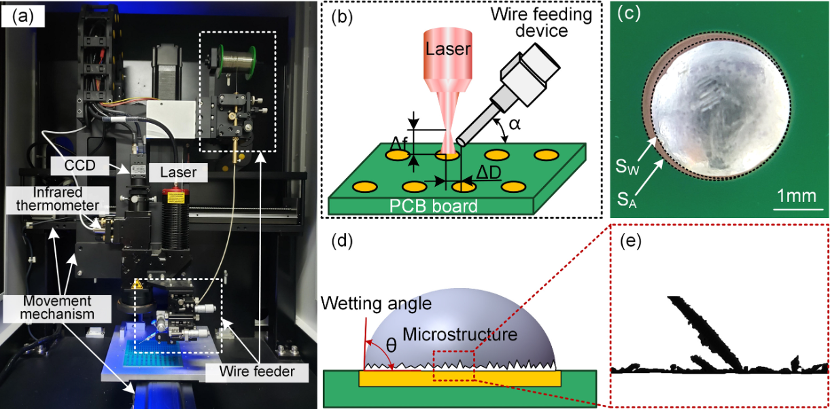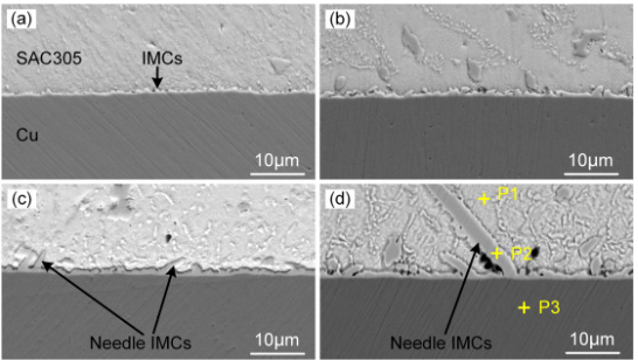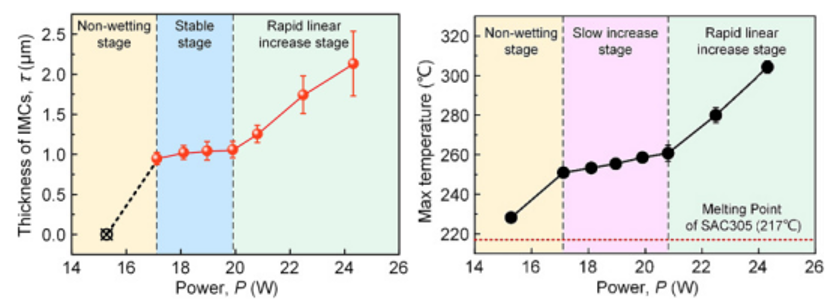The Evolution of Intermetallic Compounds during Laser Soldering_Shenzhen Fitech

The Evolution of Intermetallic Compounds during Laser Soldering_Shenzhen Fitech
With the advent of the post-Moore era, electronic components are gradually developing in the direction of miniaturization, complex structure, and functional integration. Laser soldering has become popular for improving soldering processes with its unique advantages of non-contact, selective local heating, and high precision. What we know is that laser soldering can solve the problems of difficulty in improving precision and the high cost of small batch production in traditional reflow soldering. Since intermetallic compounds play a vital role in the reliability of solder joints, researchers are eager to discover the impact of laser soldering on the evolution of intermetallic compounds in solder joints.
Experimental design
In order to understand the effect of laser soldering on IMC morphology, Zhao et al. (2023) used 0.64 mm diameter SAC305 solder wire to conduct laser soldering experiments. The Cu pad used in the test has a diameter of 3mm and a thickness of 35μm. The laser soldering system consists of a semiconductor laser (λ=915nm), an infrared thermometer, a CCD coaxial positioning system, a wire feeding device (wire feeding angle=45°), and an X-Y-Z positioning platform. Laser soldering applied laser energy (15.3-24.3W) to melt the SAC305 wire and spread it over the pad.

Figure 1. Experimental equipment and test methods. (a) Laser soldering system; (b) Laser soldering process; (c) solder joint appearance; (d) solder joint wetting angle; (d) IMC profile.
Experimental results
It can be found that when the laser power is 15.3W, the solder joint cannot be formed. Small solder joints were formed only when the laser power was increased to 17.1W. When the laser power is low, the heat input is low, and the energy absorbed by the solder fails to exceed the energy threshold to overcome surface tension. Therefore, it takes a long time for the solder ball to overcome the surface tension and spread around. As the laser power increases, the wetted area of the solder joint increases. However, when the laser power is too high (24.3W), the solder joints begin to burn and change color and the wetted area decreases rapidly. Through experiments, it was found that when the laser power is 22.5W, the wettability of the solder joint is optimal, with the wetted area percentage and wetting angle being approximately 96.5% and 34.4°, respectively.

Figure 2. Solder joint wetting angle.
Using different laser powers (P) will have different effects on IMC. For example, when the laser power is 17.1W, the IMC is in a stable stage and the thickness is thin. After the power is further increased, the IMC begins to exhibit needle-like crystals. In addition, as the laser power increases to 24.3W, needle-like IMC grows into the solder in large quantities, and its width and length are 5.06μm and 32.30μm, respectively.

Figure 3. Solder joint IMC microstructure. (a)P=17.1W; (2)P=20.8W; (c)P=22.5W; (d)P=24.3W.
By observing the IMC thickness corresponding to the laser power, it can be found that the IMC thickness increases in a step-like manner as the power increases and is closely related to the maximum temperature inside the solder. In the stable stage, since the activation energy of reaction growth of IMCs is lower than the activation energy of diffusion growth, energy is mainly used for the growth of IMCs in the horizontal direction. Meanwhile, the area where IMC has formed grows slowly, resulting in a slow change in IMC thickness. Meanwhile, since the input energy is mainly used for the diffusion of solder and the formation of intermetallic compounds, the molten pool temperature increases slowly with the increase of laser power.

Figure 4. Step phenomenon of laser power to IMC thickness and solder temperature.
Fitech's solder
Fitech is committed to the R&D and sales of electronic-grade solder materials and can provide customers with ultra-fine solder paste and powder (T6 and above). Fitech’s products include low-temperature and high-temperature solder, which has concentrated particle size, low oxygen content, less residue, and high reliability. Welcome to contact us for more information.
Reference
Zhao, S.N., Gong, M.C, Jiang, L.H.G, Cen, L. & Gao, M. (2023). Step phenomenon of intermetallic compounds thickness during laser soldering dependence on laser power. Journal of Manufacturing Processes, vol.107.

















 Back to list
Back to list



